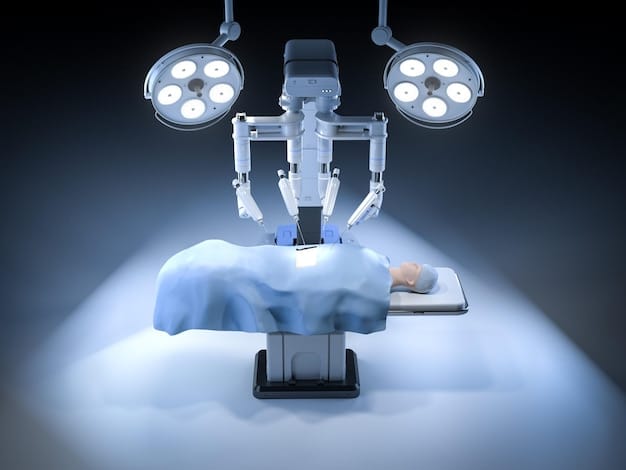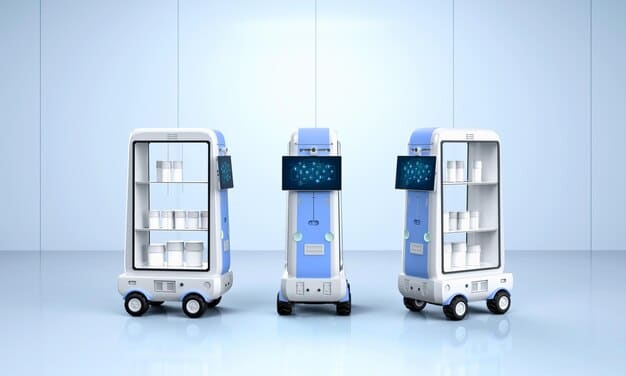Robotics in Healthcare: Automating Patient Care in the US

Robotics in healthcare is revolutionizing patient care in the US by automating tasks, enhancing precision in surgeries, and improving rehabilitation, thereby leading to better outcomes and efficiency in medical settings.
Robotics in healthcare is no longer a futuristic concept but a rapidly evolving reality transforming patient care in the United States. From assisting surgeons with intricate procedures to automating mundane tasks, robots are enhancing efficiency, precision, and overall quality in medical settings. Let’s explore how this technological revolution is reshaping the landscape of healthcare.
The Rise of Robotics in American Healthcare
The integration of robotics into the US healthcare system marks a significant leap forward. These advanced machines are not just supporting roles; they are becoming integral to various aspects of patient care, diagnostics, and hospital operations. This section delves into the foundational aspects of this technological shift.
Robotics in healthcare is transforming how medical professionals deliver care, and patients experience treatment. Let’s break down the key drivers behind this increasing adoption.
Precision Surgery and Enhanced Outcomes
One of the most significant contributions of robotics is in the realm of surgery. Robotic surgical systems offer enhanced precision, dexterity, and control compared to traditional methods, leading to better patient outcomes.
Automation of Repetitive Tasks
Robots are increasingly being used to automate repetitive tasks, such as medication dispensing and sample processing. This not only reduces the workload on healthcare staff but also minimizes the risk of errors.
- Reduced Human Error: Automation helps in minimizing mistakes in repetitive tasks.
- Increased Efficiency: Robots can perform tasks faster and more accurately than humans.
- Cost Savings: Automation can lead to long-term cost savings by reducing labor costs.
- Improved Staff Satisfaction: By automating mundane tasks, staff can focus on more critical aspects of patient care.
The adoption of robotics is not without its challenges. Issues such as cost, training requirements, and ethical considerations need to be carefully addressed to ensure successful integration. However, the potential benefits of robotics in healthcare are undeniable, paving the way for more efficient, precise, and patient-centered care.

Surgical Robots: Enhancing Precision and Minimally Invasive Procedures
Surgical robots are at the forefront of medical innovation, offering unparalleled precision and control to surgeons. These advanced systems enable minimally invasive procedures, resulting in reduced trauma, faster recovery times, and improved patient outcomes.
The da Vinci Surgical System is one of the most widely used robotic surgical platforms in the US. This technology allows surgeons to perform complex procedures with greater dexterity and precision.
Improved Surgical Accuracy
Robotic surgical systems provide surgeons with a magnified, three-dimensional view of the surgical site, allowing for more precise movements and reduced risk of damage to surrounding tissues. This level of accuracy is particularly beneficial in delicate procedures such as neurosurgery and cardiac surgery.
- Minimally Invasive: Smaller incisions lead to less scarring and pain.
- Enhanced Dexterity: Robotic arms can maneuver in ways human hands cannot.
- Improved Visualization: High-definition 3D views enhance surgical precision.
- Reduced Recovery Times: Patients often experience shorter hospital stays and quicker return to normal activities.
Training and Expertise
The effective use of surgical robots requires specialized training and expertise. Hospitals and medical centers invest in comprehensive training programs to ensure surgeons are proficient in operating these systems. As more medical professionals become skilled in robotic surgery, the standard of care is expected to improve.
Surgical robots have revolutionized the way many procedures are performed. The improved precision, reduced invasiveness, and faster recovery times are driving increased adoption across various specialties. While challenges remain, the future of surgical robotics looks promising, heralding a new era of patient care.
Robotics in Rehabilitation: Restoring Movement and Function
Beyond the operating room, robotics is playing a crucial role in rehabilitation. Robotic devices are helping patients regain mobility, strength, and function after injuries or illnesses. These technologies offer personalized and intensive therapy, often leading to better outcomes than traditional methods alone.
Robotic exoskeletons are wearable devices that provide support and assistance to patients with mobility impairments. These exoskeletons can help individuals with spinal cord injuries, strokes, or other neurological conditions regain the ability to walk and perform daily activities.
Personalized Therapy and Progress Tracking
Robotic rehabilitation systems can be tailored to meet the specific needs of each patient. These systems provide real-time feedback and data on patient progress, allowing therapists to adjust treatment plans as needed. This level of personalization ensures that rehabilitation programs are as effective as possible.
Robotic hand therapy devices can help patients regain fine motor skills and hand function after a stroke or injury. These devices provide repetitive, task-oriented exercises that stimulate neural pathways and promote recovery.
- Increased Intensity: Robotic devices allow for more intensive therapy sessions.
- Objective Measurement: Progress can be accurately tracked with data-driven feedback.
- Enhanced Motivation: Patients are often more engaged with robotic therapy.
- Improved Outcomes: Many patients experience significant gains in mobility and function.
Robotics in rehabilitation is transforming the recovery process for patients with a wide range of conditions. The ability to provide personalized, intensive therapy with objective progress tracking is leading to better outcomes and improved quality of life. As technology continues to advance, we can expect even more innovative robotic solutions to emerge in the field of rehabilitation.
Automated Medication Dispensing: Enhancing Accuracy and Safety
Medication errors are a significant concern in healthcare, leading to adverse patient outcomes and increased costs. Automated medication dispensing systems are designed to reduce these errors by ensuring that patients receive the correct medication, at the right dose, and at the right time.
These systems use barcode scanning, robotic arms, and computerized records to streamline the medication dispensing process. This reduces the risk of human error and improves overall patient safety.
Streamlined Medication Management
Automated dispensing systems can integrate with electronic health records (EHRs) to provide a seamless medication management process. This integration ensures that medication orders are accurately transmitted, filled, and tracked, reducing the potential for communication errors.

- Reduced Errors: Automation minimizes the risk of dispensing the wrong medication or dose.
- Improved Efficiency: Medication dispensing is faster and more streamlined.
- Enhanced Safety: Real-time tracking and verification improve patient safety.
- Cost Savings: Automation can reduce waste and improve inventory management.
Automated medication dispensing systems represent a significant advancement in patient safety and healthcare efficiency. By reducing the risk of medication errors and streamlining the dispensing process, these systems are helping to ensure that patients receive the best possible care. As technology continues to evolve, we can expect these systems to become even more sophisticated and integrated into the healthcare ecosystem.
Robots in Logistics and Support: Streamlining Hospital Operations
Beyond direct patient care, robots are playing an increasingly important role in hospital logistics and support functions. These robots are used to transport supplies, medications, and even meals, freeing up healthcare staff to focus on more critical tasks.
Autonomous mobile robots (AMRs) are designed to navigate hospital environments safely and efficiently. These robots use sensors, cameras, and sophisticated algorithms to avoid obstacles and find the best routes. They can operate 24/7, ensuring that essential supplies are always available when needed.
Efficient Transportation of Supplies
Robots can transport linens, medical equipment, and other supplies throughout the hospital, reducing the burden on nurses and other staff members. This allows healthcare professionals to spend more time on direct patient care, improving the overall quality of service.
Robotic delivery systems can transport lab samples, medications, and other time-sensitive materials quickly and efficiently. This can help to reduce turnaround times and improve patient outcomes.
- Increased Efficiency: Robots can handle routine transportation tasks around the clock.
- Reduced Workload: Staff can focus on higher-value responsibilities.
- Improved Timeliness: Supplies and medications are delivered when and where they are needed.
- Enhanced Safety: Robots can handle hazardous materials and reduce the risk of injury.
Robotics in logistics and support is revolutionizing hospital operations by streamlining transportation tasks and freeing up healthcare staff to focus on patient care. The use of autonomous mobile robots is helping to create more efficient, safe, and patient-centered healthcare environments. As technology continues to advance, we can expect even more innovative robotic solutions to emerge in this area.
Challenges and Ethical Considerations
While robotics offers numerous benefits to healthcare, it is important to address the challenges and ethical considerations associated with its implementation. Issues such as cost, training requirements, data privacy, and the potential for job displacement need to be carefully considered.
The initial investment in robotic systems can be substantial, making it difficult for smaller hospitals and clinics to adopt these technologies. However, the long-term cost savings and improved patient outcomes can often justify the investment.
Data Security and Patient Privacy
Robotic systems generate vast amounts of data, raising concerns about data security and patient privacy. It is essential to implement robust security measures to protect this data from unauthorized access and ensure compliance with privacy regulations such as HIPAA.
The increased use of robotics in healthcare raises questions about the role of human healthcare professionals. It is important to ensure that robots are used to augment, rather than replace, human caregivers.
- Cost: High initial investment can be a barrier to adoption.
- Training: Specialized training is required for staff to operate and maintain robotic systems.
- Data Privacy: Protecting patient data is essential.
- Ethical Concerns: Ensuring that robots are used ethically and responsibly.
Addressing these challenges and ethical considerations is essential to ensure that robotics is implemented in a way that benefits both patients and healthcare providers. By carefully considering the potential risks and benefits, we can harness the power of robotics to create a more efficient, effective, and patient-centered healthcare system.
Future Trends in Healthcare Robotics
The field of healthcare robotics is constantly evolving, with new technologies and applications emerging all the time. From advanced surgical systems to intelligent assistive devices, the future of healthcare robotics is full of potential.
Artificial intelligence (AI) is playing an increasingly important role in healthcare robotics. AI-powered robots can analyze data, make decisions, and even learn from experience, allowing them to perform complex tasks with minimal human intervention.
Integrating AI and Machine Learning
AI and machine learning algorithms are being used to develop robots that can personalize treatment plans, predict patient outcomes, and even diagnose diseases. These technologies have the potential to transform the way healthcare is delivered.
Nanobots are microscopic robots that can be injected into the bloodstream to diagnose and treat diseases at the cellular level. While still in the early stages of development, nanobots have the potential to revolutionize medicine.
- AI-Powered Robots: These robots can learn and adapt to provide personalized care.
- Nanobots: Microscopic robots can diagnose and treat diseases at the cellular level.
- Telepresence Robots: These robots allow physicians to remotely monitor and treat patients.
- Collaborative Robots: Robots that work alongside healthcare professionals to enhance efficiency.
The future of healthcare robotics is bright, with new technologies and applications on the horizon. As technology continues to advance, we can expect to see even more innovative robotic solutions that improve patient outcomes, enhance efficiency, and transform the way healthcare is delivered.
| Key Aspect | Brief Description |
|---|---|
| 🩺 Surgical Robots | Enhance precision, reduce invasiveness, and speed up recovery in surgeries. |
| 💪 Rehabilitation Robots | Assist patients in regaining mobility and function through personalized therapy programs. |
| 💊 Medication Dispensing | Automate the dispensing of medications to minimize errors and improve patient safety. |
| 📦 Logistics Robots | Streamline hospital operations by transporting supplies and reducing the workload on healthcare staff. |
Frequently Asked Questions
▼
Robotics in surgery offers enhanced precision, minimally invasive procedures, reduced trauma, faster recovery times, and improved patient outcomes compared to traditional surgical methods.
▼
Rehabilitation robots provide personalized and intensive therapy, assisting patients in regaining mobility, strength, and function after injuries or illnesses. They offer real-time feedback and data tracking.
▼
Automated medication dispensing systems reduce medication errors, streamline medication management, improve efficiency, enhance safety, and can lead to cost savings by reducing waste.
▼
Robots streamline hospital operations by efficiently transporting supplies, medications, and meals, freeing up healthcare staff to focus on more critical tasks and improving overall service quality.
▼
Key ethical considerations include addressing cost, training requirements, data privacy, potential job displacement, and ensuring that robots augment, rather than replace, human caregivers to maintain patient-centered care.
Conclusion
The integration of robotics in healthcare in the US is revolutionizing patient care by enhancing precision, automating tasks, and improving rehabilitation outcomes. While challenges such as cost and ethical considerations remain, the benefits of robotics are undeniable, paving the way for a more efficient, effective, and patient-centered healthcare system.





